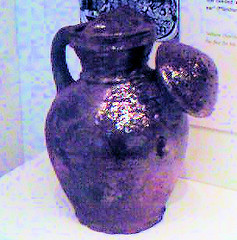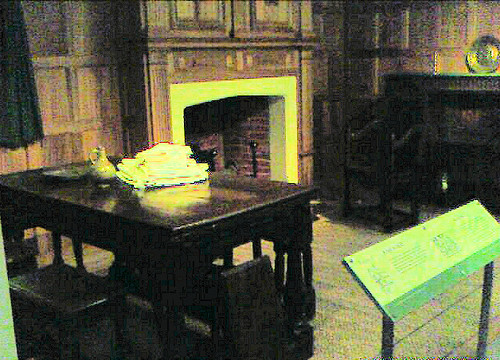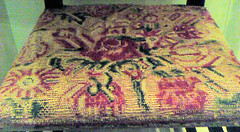By Natalie Bennett
As your bus passes up the Kingsland Road, you might wonder where it is taking you. In this densely packed mass of council estates, dubious mobile phone shops and dismal “convenience” stores, are you really going to find a history museum? But fear not, for soon, looming up on your right as you leave the city behind, is a vision of peace, tranquility and Georgian benevolence – the Geffrye Museum.
 It is the complex of almshouses founded in 1714 by Ironmongers’ Company in memory of Sir Robert Geffrye, a wealthy member who left a large part of his estate for philanthropic purposes. Once there were 14 houses with accommodation for 50 pensioners in total, each having their own room.
It is the complex of almshouses founded in 1714 by Ironmongers’ Company in memory of Sir Robert Geffrye, a wealthy member who left a large part of his estate for philanthropic purposes. Once there were 14 houses with accommodation for 50 pensioners in total, each having their own room.
By 1912, however, the once rural almshouses had been swallowed by urbasisation and the pensioners were moved out of London, the local council seeing the need most of all to preserve the front garden as a badly needed “lung” for the area. The building was re-opened in 1918 as a museum of furniture and woodwork.
Today it styles itself as a museum of “the middling sort”, focusing on domestic interiors and gardens from Tudor to modern times. That there might be a certain irony in celebrating the middle classes in one of the most deprived areas of London is undeniable – but perhaps it is best regarded as an aspirational approach.
The core of the museum is a succession of reconstructed rooms, with explanatory sections between them, but it begins with a single room that tells a history in chairs – “middle-class chairs from 1620s to the present”. It is a display that has an odd circularity from the solid oak armchair of first period with its straight simple lines, to the minimalist Jasper Morrison chair of 1985. The padding has swelled up, at its peak in a 1860 mahogoney side chair, then faded away. The next room tells you the 17th-century example was often called the “great chair” and reserved for the head of household or someone they wanted to make feel important. So that’s circular too then.
In line with modern museum approaches there’s plenty to touch, feel and even sit on. You can lay hands on a range of furnishing materials of the period, from “saye”, some of which Pepys is recorded as buying for his parlour curtains, to the horsehair (made from the long mane and tail hairs) that was woven on a linen, cotton or woolen warp and used to cover chairs and sofas from mid-18th century. (It was handily wipe clean.)

Often in such displays it is the small items that provide the surprises, and the salutory reminders that life is ever-changing. You might look at this late 16th-century earthenware watering pot and think it was a bit heavy to carry around the garden, and you’d be right, for this was for indoor “gardening” – used to keep down the dust in plaited rush matting. Beside it is a “fuming pot” from 17th century – we’d call it an incense burner.

The “room” displays begins with 1620, with a first-floor hall, as might have been owned and furnished by a successful London merchant, in a style that changed little from at least 1580 to 1660. Business would have been conducted on the ground floor and here was where the whole household, including the apprentices, read, sewed, ate and played games such as backgammon. The court or press cupboard in the background would have been used for display of the household’s best items and at mealtimes for keeping the drinks on.
Moving forward, the antechamber to the 1695 house offers a selection of papers of the time for your reading pleasure – The Tatler and The Spectator. I was taken by an advert in the latter’s October 16, 1711, edition for “the famous Bavarian red liquor” which “gives a delightful blushing Colour to the Cheeks of those that are White or Pale, that it is not to be distinguished from a natural fine Complexion”. It was sold at 3s 6d a bottle “with directions”.
 Perhaps such little helpers had always been around, but the whole great beast of fashion can be seen to start to uncurl at the end of the 17th century. This is a chair (original and very rare) covered in “Turkey work”, a carpet-like weaving that from the 1660s to 1680s was very popular. But it was overtaken by cane, the material for which was imported from Asia. Not as sexy perhaps as spices, but presumably there must have been money in it.
Perhaps such little helpers had always been around, but the whole great beast of fashion can be seen to start to uncurl at the end of the 17th century. This is a chair (original and very rare) covered in “Turkey work”, a carpet-like weaving that from the 1660s to 1680s was very popular. But it was overtaken by cane, the material for which was imported from Asia. Not as sexy perhaps as spices, but presumably there must have been money in it.
Gradually also, parlours and dining rooms replaced halls as the main living space. The furniture is lighter and less robust (it didn’t have to survive those apprentices, as they increasingly transformed into servants and were banished to the margins of the house). Clocks and mirrors appear.

So it is that by 1745 you get a real leap towards the “modern” in the polite parlour. The commentary imagines a mother and her daughters being called on by acquaintances for whom they make tea. After dinner the family will spend evening hear reading novels and writing letters.
This new ambition to culture is spelt out in the words of Dudley Ryder, a linen draper’s son, and you can just read in his words a pretentious young sprat. In his diary in 1715 he wrote “read when came home some of Horace’s odes and translations of them. They are full of admirable sense and excellent humour. One cannot read any book I believe more fit to learn one the polite way of writing and conversing than Horace.”
The next big revolution is in lighting – gas lighting was widely used in middle-class homes from 1840s and at the same time paraffin lamps largely replaced oil, being efficient, convenient and cheaper. The gas was very sooty until the 1880s, when gas mantles were developed.
Still, fashion was sweeping along. So complained Robert Eddis in 1881:
Twenty years ago, few people knew or cared much about thr artistic character of the surroundings of their daily life. The ordinary english homes were fitted up either in the dreariest monotony of commonplaces, or made gaudy with paper_hangings and floor-coverings of vulgar colour and design.
Another annoying young sprog you think, but then when you see the 1830 and 1870 drawing rooms — a riot of clashing colours and patterns — you might think he had a point. Why did all reasonable sense of taste disappear in the 19th century? Perhaps it was because society had to take time to absorb the sudden advent of affordable mass production and come to understand that more wasn’t always better. The 1890s Aesthetic Movement drawing room presented here is a great improvement, although still hopelessly over-busy for the tastes of today.
After you pass temptingly by the cafe (hold off, and go outside to one of the excellent Vietnamese joints on Kingsland Road for some delightful cold spring rolls) you are in the 20th-century – half a dozen offerings from suburban Sixties idylls to the Nineties loft living. I found a frisson of recognition in the Sixties description of “paintings and reproductions of famous artworks were hung in plain wooden frames”. I hadn’t thought of it for years, but suddenly I was reminded of a very bad print of a oil painting of the sea that hung over my grandparents’ television. The museum does miss out on the miss the ducks flying up the wall though – something they should definitely include in the next revamp.
Entry to the Geffrye Museum is free. In the downstairs gallery there’s a range of temporary exhibitions – now Home and Garden Part 3 (1914-1960), until June 24.
Leave a Reply